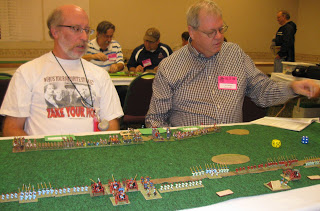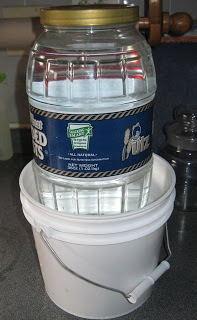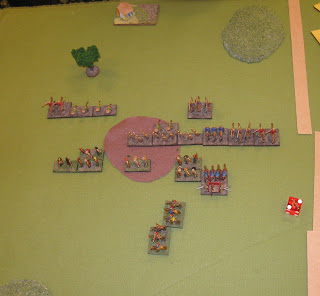JM and I formed “Team Red Meat” at the Fall-In BBDBA doubles competition. The name was inspired by a combination of factors: we’re first time competitors, aka “fresh meat;” and I really enjoy the Red Meat comic. Unfortunately I never remembered to say “I hate you, Milkman Dan!”
Larry heckled us a bit for planning ahead and bringing a document describing our plans. Yes, we were inspired by the Two Davids who make similar documents in preparation for their battles. However, our goal was not primarily to win. We only wanted to fail to make utter fools of ourselves, and I think we succeeded.
Planning ahead allowed us to think on our own time instead of wasting our opponents’ time, and gave us a baseline to measure what worked and what didn’t so we could learn more quickly. Neither JM nor I have a very strong knowledge of historical tactics used by real generals, and neither of us have much experience in BBDBA or other larger scale Ancients games, so planning was also intended to offset our deficit in experience. I’m glad we did it and we’ll likely do it again, for similar reasons.
There were eight entries in this tournament. The field was split by army year into two groups of 4, and everyone played everyone else in each group. The winners in each group played the finals some time after the convention was over; I never heard the final result.
We fielded Warring States Chinese: Chao (II/4c). As seen in earlier posts, I painted two of the armies and JM painted the third. No one noticed our use of 3Cb instead of 4Cb or our single Russian light horse stand in with the Chinese; though neither had any effect on gameplay. Our command split was the same in all our games:
- Mid PIP (C-in-C): 2xHCh (gen), 3x2LH, 6x4Sp, 3x4Cb, 2x2Ps; 16 elements, breakpoint 6
- High PIP: 4xHCh (gen), 3x2LH, 3x4Sp, 3x4Cb; 13 elements, breakpoint 5
- Low PIP: 3x4Sp (gen), 3x4Cb, 1x2Ps; 7 elements, breakpoint 3
 |
| Stooges: Larry and Will |
Our first game was against Larry and his honorary Stooge partner Will. “We came all this way to play against you?” They brought Seleucids (II/19), which combined the elements that posed our greatest anticipated challenge: pikes and elephants. We forgot about the possibility of Scythed Chariots, and they were the killer this game.
We defended, and set up terrain as planned: three small central hills with a road the long way behind one. It wasn’t much, but we placed it where we hoped we could take more advantage of it than our enemy.
The plan for elephants was to avoid them, or try to shoot them with bows. Larry had an interesting command structure around his elephants: he combined three elephants and three scythed chariots with one other element. Since the expendible chariots don’t count towards the break point, the command needs to lose 6 of its 7 elements before it’s destroyed, providing additional protection for the elephants.
 |
| Death by Scythed Chariot |
For the pike, we wanted to outflank them with light horse and peel them apart. Unfortunately, they used their pike in passive defense of a well defended position. We decided to win elsewhere, and didn’t approach the pike. I’m not sure if this was a good idea or not.
Our failure and prompt demise came on the opposite flank. Will’s scythed chariots totally destroyed our line, and then broke through to the road where they could kill whatever they wanted. These things are called “expendibles” for a reason: they aren’t supposed to live very long. Will rolled really well a few times, and that provided him with the tactical advantage to roll us up. This was our fastest loss in the tournament. One important lesson I learned here, was to pay attention when to let your broken command flee. They’re only useful when they’re still in the way; after that, they’re screwing up the high/low/mid PIP die rolls.
 |
| Two Davids: Kuijt and Schlanger |
|
In the second game, we faced the Two Davids: David Schlanger and David Kuijt playing some kind of Romans (Early Imperial, I think) with an ally (Arabo-Aramean, I think). Their army didn’t have any particularly problematic elements, but the Davids are very good players.
We defended again, and placed a waterway to reduce our time to contact. It did an adequate job of that, but probably wasn’t really necessary since neither of us was particularly fast.
They refused our left flank with their artillery and forced us to play our attacking force on our right.
This was a very interesting game, I enjoyed it a lot. There was a lot of back and forth on our attacking flank, but the Davids did a great job and I learned a lot. We had some localized advantages on occasion, but unfortunately I missed our prime opportunity to pull a win from the jaws of defeat. I had a chariot within striking range of the enemy camp, and asked DS about the finer points of attacking a camp. I decided not to attack the camp, but in the mean time I missed the fact that I could’ve flanked their commander in chief, which might have ended the game in our favor instantly. Instead, they broke our high PIP command, then a second command, and won.
 |
| A lesson on the virtues of a subtly painted C-in-C |
|
The Davids did a wonderful job of using two of their commands against one of ours, and winning through PIP advantage. The high PIP Roman command and the allied command were next to each other, and moved into overlapping positions. This allowed both commands to work together and share PIPs, whether the critical position ended up being in the center or on the flank. We tried to start doing this later in this game and throughout our next game, but since we hadn’t planned for it, we didn’t do a great job.
I think the Davids’ choice to use an Ally makes this easier: by placing the ally next to the high PIP command, they can always easily tell which elements are a part of each command. The downside is that ordinary maneuvers are always more expensive since they’re split across two commands and can’t use a single PIP group move.
 |
| Team Canuk: Colin Rice and Michael Saunders |
Our third game was against Team Canuck: Michael Saunders and Colin Rice. They played Patrician Roman (East) II/83b, I believe. They had a wide variety of troops, but without any elements that were particularly problematic for us.
They defended and placed terrain: a wall of woods down the center of half the board, a road perpendicular, and the rest of the board empty. They set up their first two commands in the open area, and left their bad going troops (aux, warband) in their last command.
We didn’t stand a chance in the woods, so we compressed our spears into double ranks against their knights and stuffed ourselves into narrow frontage in the open. We tried to overlap our commands somewhat, but we limited this to the elements we could tell apart when they stood next to each other. They deployed their light troops behind their main line, and the entire battle was limited to one half of the board.
 |
| They redeployed on their baseline while we ran hell to leather |
They ended up spending several turns to redeploy and maneuver their troops without advancing at all, before we made contact. We were running as fast as we could, but just couldn’t get there before they had time to fix their deployment problems.
Once our lines met, we had an advantage early on and damaged all of their commands, but none to the breaking point. It felt like we had a real chance of winning. We even had several 4-3 rolls against their C-in-C, but they all failed.
Finally, the Canadian luck turned, and they broke our commands before we did anything else to theirs. Just before time ran out for the round, they killed us.
I really enjoyed this event, and I look forward to playing BBDBA Doubles again. JM and I worked well together, and I think with a few refinements we can increase our expectations to include actually winning a game. Our plans were not obviously bad, and I’m glad we spent time on them. Their simplicity helped us implement them correctly.
Neither of us are content with our army choice, but we want to revisit the army “later.” Warring States Chinese are quite low on bad going troops, and don’t have many different element types available.
Between the two of us, we have enough BBDBA armies to practice together effectively, and with our current level of motivation we should probably start soon. I wouldn’t want to give any secrets away, so I won’t mention our options for Cold Wars.













